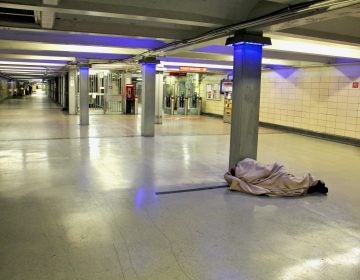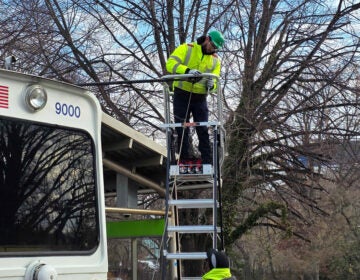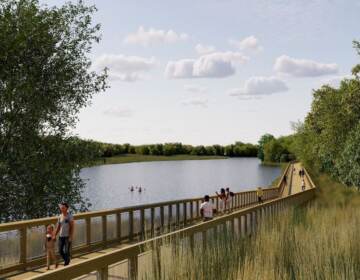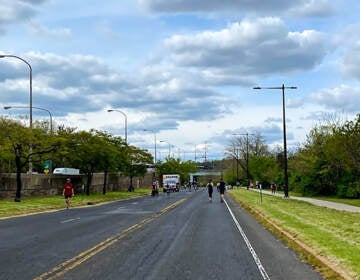‘Change is hard’: Why the future of a car-free MLK Drive remains in flux
MLK Drive became a popular biking and walking path during the pandemic. As city officials prepare to reopen it, advocates see opportunities to share the road better.
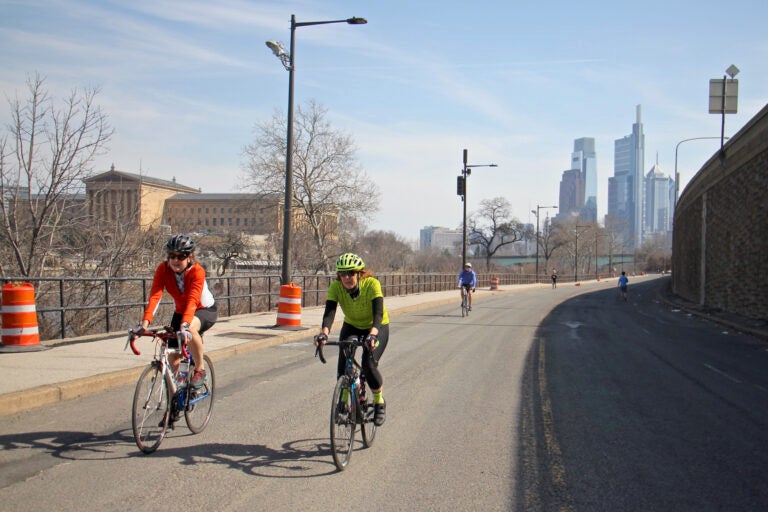
Cyclists and joggers use Martin Luther King Drive on March 11, 2021, which has been closed to traffic since the start of the pandemic. (Emma Lee/WHYY)
Days after City Hall announced that Martin Luther King Drive will reopen to auto traffic in August, bicycle and pedestrian advocates say the future of the scenic roadway is still in play.
To them, the news came as a defeat after months of advocacy to make the closure permanent and a related petition that has drawn more than 5,000 signatures. But Randy LoBasso, from the Bicycle Coalition of Greater Philadelphia, which authored the petition, said his group isn’t giving up their efforts. The group is planning a rally to highlight the success of the temporary closure to traffic and says if they can’t stop automobiles from returning, they want to see a mutually acceptable compromise –– perhaps splitting up the roadway to allow for car lanes while also expanding bike and pedestrian areas.
“It’s a four-lane speedway through a park and it was part of the city’s high injury network,” he said. “I don’t think the people injured or killed there thought it was working before the pandemic.”
Mayor Jim Kenney’s administration said the reintroduction of traffic would come along with some $1.4 million in improvements to the existing MLK Drive bike and pedestrian trails, including upgrades to lighting and paving. But in City Council hearings, Councilmember Curtis Jones made it clear a big push to reopen the park drive came from community groups in his West Philadelphia district.
Crystal Morris, president of the Wynnefield Residents Association, one of the groups that reached out to Jones, said their opposition came out of a sense that the closure sent more traffic into their community.
“We’re the passthrough for everyone trying to get downtown,” she said.
Without MLK open to cars, she said, more traffic came through neighborhood arterials like Belmont or Parkside avenues, as drivers searched for other ways to avoid gridlock on the famously congested Schuylkill Expressway.
“We’re excited that it’s reopening,” Morris said, of the park drive. “We understood the benefits and it was a great opportunity. But as things are opening up and as traffic is picking up it’s more of a hardship.”
She said neighboring community groups in Wynnefield Heights, Overbrook, and Parkside expressed similar concerns, while others recently floated a counter-petition that has drawn around 200 signatures.
“This community isn’t made up of cyclists,” Derrick Howie, vice-president of Wynnefield Block Captains, the group that authored the counter-petition, said. “There’s a big group of people who aren’t interested in riding their bikes. They want to drive.”
Morris and Howie also presented the issue as one of equity, with older and predominantly African-American neighborhoods bearing this impact, while their groups’ members felt like they hadn’t been part of initial conversations about road closures.
Jones, who lives in Wynnefield and spoke out earlier this week on behalf of his neighbors, echoed similar concerns about the failure to reach out to affected communities.
“Many adjacent neighborhoods, from as far away as Mt. Airy to Parkside, have protested the closure because of the inconvenience of travel as well as increased traffic due to the detours,” he said, in a statement. “Future closure times must be negotiated with communities most impacted by them.”
Jones’ views carry a lot of weight, according to the Kenney administration.
“City Council is obligated to approve any long-term changes to the use of public streets by ordinance,” said Mike Carroll, Deputy Managing Director for Transportation. “We are grateful to Council for managing engagement with communities impacted both positively and negatively by the closure and for disseminating updates to the public at large.”
Councilmember Jamie Gauthier, whose district also includes part of MLK Drive, did not take a stance on reopening.
‘Change is hard’
The city plans to resume seasonal weekend closures of MLK between April and October, a practice which took place for many years prior to the pandemic, and “opportunities to extend these closures are being explored,” according to a city spokesperson.
Carroll described the drive as an “essential” route for traffic diversions as rehab projects affected the MLK Bridge and the East Falls Bridge, at the Northern and Southern ends of the roadway. He also acknowledged residents’ traffic concerns.
“As traffic levels return to normal residents living to the North and West of the City will retain access to Center City, and as special events schedules return to pre-pandemic patterns, MLK Drive will play a key role in managing circulation,” he said.
LoBasso said his group had met with Jones’s office, other city officials, businesses and community groups 23 times to discuss the closure. He reached out to Morris’ group back in January, and others in the area during the spring after BCGP learned Jones’ had sent a letter articulating his opposition to permanent closure.
“I understand where they’re coming from,” LoBasso said of the West Philadelphia residents who oppose the road closure. “Change is hard and they felt like they weren’t being communicated with. What I do hope is that between now and August the city can come up with what configuration it wants MLK to look like.”
Morris said her group had opposed eliminating some of MLK Drive’s four traffic lanes and instead suggested opening and closing the roadway during peak travel times.
She said her neighbors used MLK to bypass traffic on the expressway.
“We have more seniors who prefer taking the river drive to taking the expressway,” Morris explained.
In some of these informal conversations with the Bicycle Coalition about possible compromises, conversation turned to other alternatives to the expressway, she noted.
She recalled someone asking if residents might opt to take Kelly Drive, which runs parallel to MLK on the other side of the river, as another alternative to the expressway.
“Kelly Drive takes you out of your way,” Morris said. “You’re crossing the bridge and it’s out of the way for no real reason. I said why not close down Kelly Drive?”

Subscribe to PlanPhilly
WHYY is your source for fact-based, in-depth journalism and information. As a nonprofit organization, we rely on financial support from readers like you. Please give today.




